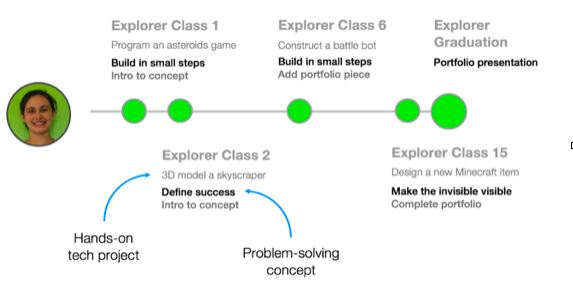
Learn & Play in our Digital Sandbox

Categorized under: technology education for kids
Technology literacy is no longer just an advantage, but a prerequisite to thrive in a complex, technology-driven world. Unfortunately, students do not have access to high quality technology education. Existing options are either too complex, boring or narrowly focused on low-level skills like programming syntax. These options might help students become coders who can translate someone else’s instructions into a programming language, but they will never develop students into high level tech problem solvers.
Great technologists, like Bill Gates, didn’t learn how to build with technology through coursework. Instead, their curiosity led them to get their hands dirty. They experimented, tried, failed, iterated and then succeeded. This playful process is highly effective for learning generalizable problem-solving skills.
We aim to democratize these processes that great technologists went through to learn their skills. We emulate their methods of experimental play but structure them in a way that’s accessible for all learners. By focusing on problem-solving instead of a specific skill, like programming, our students grow to be creative, persistent technologists. And our playful approach ensures they have a blast getting there.
Our curriculum is designed to be accessible to new or casual learners but also offer enough depth to engage advanced or ambitious students. It’s proficiency based and tied to skill demonstration. This means that students only move on when they’re ready, not when they’ve completed an arbitrary number of classes or projects. Our curriculum also centers around problem solving and progressive independence as opposed to rote technical skills. To give parents and students a sense of progression, we divide the curriculum into three levels: Explorer, Developer and Hacker.
All students start at the Explorer Level, where they gain exposure to the 6 different topic areas and 15 different tech platforms that we teach at Digital Adventures. In addition to this broad-based exposure, we tie these experiences together by introducing students to a generalizable problem-solving toolkit. As an example, take Ana.

Ana just signed up for the Tuesday 4 – 5pm Ultimate Adventure class. Her first day, she programs an asteroids video game. But she is also introduced to the general problem solving technique of “Building in Small Steps”. Ana’s instructor unobtrusively assesses her understanding and application of this technique, organically prompting Ana to use the technique as needed during class.
On her second day, Ana designs a 3D model of a skyscraper and learns about the general problem solving technique of “Defining success”. Each week she’ll complete a fun, hands-on project while learning how our problem solving toolkit can be applied to many different situations.
In week 6, Ana is ready to record a multimedia demonstration of each problem solving technique to start building up her learning portfolio. Whenever her learning portfolio is complete, in her case at the 15-week mark, Ana will graduate from the Explorer Level to the Developer Level, where she continues to solidify her problem solving toolkit and chooses a domain concentration based on her interests, such as Programming, Design or Product Management.
When she demonstrates sufficient technical proficiency in her chosen area, which will take anywhere from 6 – 18 months, Ana graduates to the Hacker Level. This is the steady state of independence that we want all of our students to achieve. At the Hacker Level, students can come into our studio on their own schedule to design and build their own projects. However, students at this level are mostly independent and can advance their learning without structured classes. They still continue to come to Digital Adventures for ad hoc instructor support, to access our equipment and to connect with the community they’ve built over time with their peers.
By focusing our curriculum on proficiency, we prioritize students achieving the ultimate outcome which is the capability to bring their idea to reality independently. While this process may require more patience, we believe that it builds the skills within the next generation of creative problem solvers to change the world.


 By:
By: